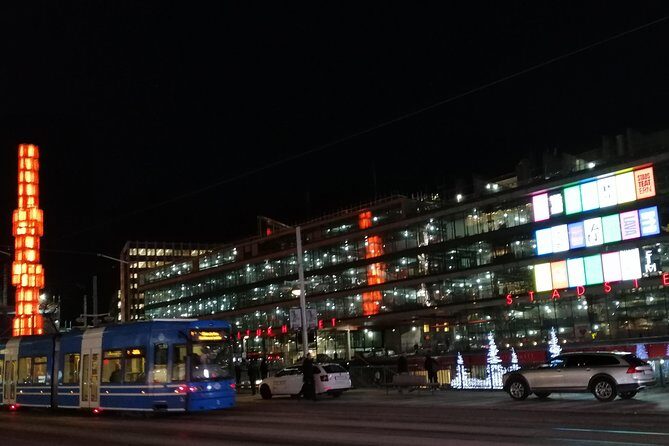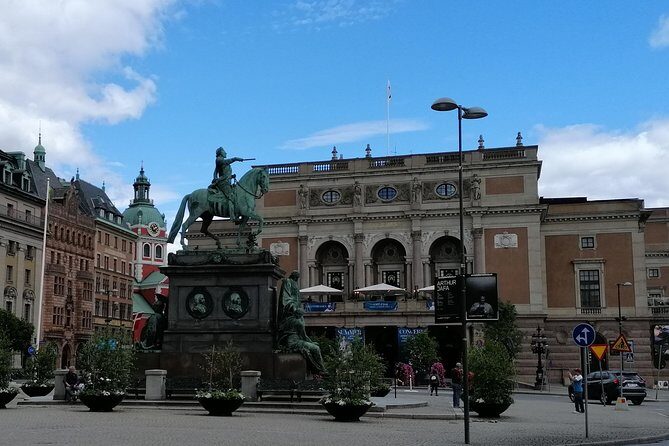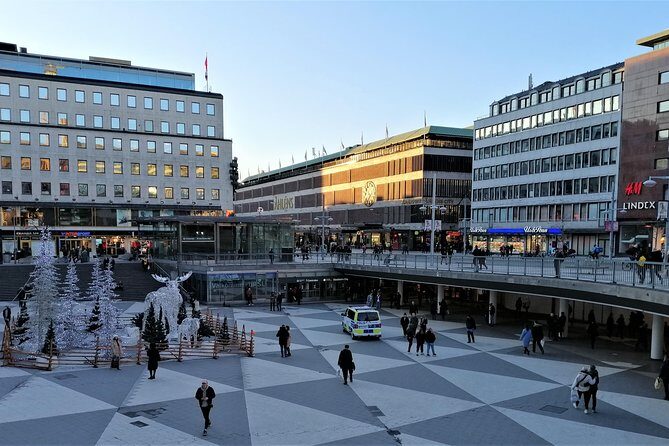Stockholm: Modern City and Old Town, a Small Group Walking Tour offers an engaging glimpse into Sweden’s capital, blending sleek modern architecture with centuries-old charm. For $75.24 per person, you’ll spend approximately two hours walking through the city’s most notable spots, guided by knowledgeable locals who are eager to share insights and answer questions. With a small group size capped at 10 travelers, this tour provides a personalized experience that caters to those who appreciate storytelling and authentic atmosphere.
What we really like about this tour is the chance to see both sides of Stockholm—the bustling, modern city center with its innovative architecture and the deeply historic Old Town with its cobblestone alleys and medieval buildings. The tour’s focus on Swedish inventors and entrepreneurs adds a fascinating dimension beyond the usual sightseeing, making it both educational and inspiring. Plus, passing by the Spotify office and learning about Stockholm’s entrepreneurial spirit sparks a contemporary connection to the city.
One potential consideration is that this is a walking tour covering quite a bit of ground in just two hours, so comfortable footwear and moderate fitness are recommended. Some travelers, like one reviewer, found the city too small for a walking tour, but most appreciated the depth of information packed into a short duration, especially with the personalized attention that only a small group allows.
This tour suits travelers who love history, architecture, and stories of innovation. It’s perfect for those who want a balanced view of Stockholm’s past and present without the hassle of navigating on their own. If you’re a curious traveler who enjoys asking questions and soaking in local stories, this tour is a great pick.
Key Points

- Balanced Itinerary: Combines modern architecture with medieval charm for a comprehensive look at Stockholm.
- Personalized Experience: Small group size ensures ample opportunity to ask questions.
- Historical & Cultural Highlights: Passes iconic sites like the Royal Palace and Old Town, along with modern landmarks like Sergels Torg.
- Educational Focus: Highlights Swedish inventors, entrepreneurs, and the city’s transformation after WWII.
- Convenient & Value-Driven: Price reflects a well-rounded, two-hour experience with expert guidance.
- Accessible for Most: Moderate walking suitable for most travelers, but wear comfortable shoes.
In-Depth Review of the Tour
If you're drawn to exploring Stockholm on foot, we've looked into these other walking experiences
Starting Point: Konserthuset Stockholm
The tour kicks off outside the Konserthuset, Stockholm’s grand concert hall, a fitting place to begin as it symbolizes the city’s cultural sophistication. Our guide (whose name wasn’t specified but was described as engaging and knowledgeable in reviews) provides an introductory overview of Sweden and Stockholm, setting the scene for what’s to come. This initial moment frames the city not just as a collection of buildings but as a place shaped by history, innovation, and cultural pride.
While the ticket for the concert hall isn’t included, the short introduction helps orient you and sparks curiosity about Stockholm’s artistic scene. It’s a good starting point, especially for first-time visitors eager to get a sense of the city’s vibe.
The Twin Towers of Kungstorn
Next, the group passes by the Kungstorn (King’s Towers)—twin skyscrapers built between 1919 and 1925, considered the first modern skyscrapers in Europe. Standing here, it’s easy to appreciate how Stockholm was embracing modern architecture early on, breaking away from traditional styles. The fact that these towers are free to view makes this stop a quick but impactful glimpse into early 20th-century urban development.
Sergels Torg and the Post-War Renewal
Moving on, we visit Sergels Torg, the heart of Stockholm’s mid-century renewal. The city council’s decision in 1945 to modernize Stockholm led to the demolition of over 750 buildings—a massive upheaval that reshaped the cityscape. Today, Sergels Torg is both admired and criticized for its stark, modernist design. It’s a landmark that tells a story of urban ambition and the challenges of modernization.
Here, you’ll see the Kulturhuset Stadsteatern, a symbol of Swedish modernism and cultural growth. The guide shares insights into how this area reflects Sweden’s evolving identity, which helps us understand the city’s layered character—old meets new, tradition meets innovation.
Brunkebergstorg and Urban Development
We pause briefly at Brunkebergstorg, an inner-city square that illustrates Stockholm’s ongoing redevelopment. Once surrounded by older buildings, it’s now a hub for finance, hotels, and restaurants. The mention of Urban Escape, a project by real estate firm AMF, highlights a modern approach to workspaces—more open, innovative environments designed to attract young professionals. This stop underscores how Stockholm continues to evolve, blending historic spaces with contemporary urban planning.
For broader city exploration in Stockholm, we've covered these other tours
- Stockholm City Tour + VAASA Museum VIP car (private service)
- Airport Limousine Transfer: Stockholm City to Arlanda Airport 1-7 Passengers
- Winter Kayak Tour in Stockholm City (Dry Suit Kayaking)
- Walking Tour of Stockholm’s City Center
- Stockholm City Kayak Tour
- Stockholm Private Tours by Locals: 100% Personalized, See the City Unscripted
The Statue of Gustav II Adolf and Swedish Naval Power
Passing the Gustav II Adolf statue offers a chance to learn about Sweden’s military past. Gustav II Adolf, a king remembered as a warrior leader, was responsible for commissioning the Vasa warship, which symbolizes Swedish naval prowess. The guide’s storytelling here connects Stockholm’s history with its maritime ambitions, giving travelers a sense of the nation’s growth through military and exploration efforts.
The Riksdag and Royal Palace
Next, we explore the Parliament Building (Riksdagshuset). Our guide explains how Sweden’s parliamentary system evolved from the Riksdag of the Estates to a more democratic structure in 1921. This provides context for Sweden’s political stability and social progress.
Standing outside the Royal Palace on Lejonbacken, we witness a site of regal grandeur. The statue of Carl XIV Johan and the nearby monument of Gustav III tie together Sweden’s monarchical history with its enlightenment-driven cultural achievements. The Royal Palace itself is a stunning reminder of royal heritage, and although the tour doesn’t go inside, passing by the exterior offers plenty to admire.
Medieval Heart: Stockholm Old Town
The final major section takes us into Stockholm’s Old Town, one of Europe’s best-preserved medieval centers. Narrow cobbled streets, colorful buildings, and historic landmarks create a vivid picture of Stockholm’s origins. Our guide shares stories of the city’s birth, reinforcing the idea that beneath its modern veneer lies a deep sense of history.
Stortorget, the main square, is lively and picturesque, with cafes and restaurants lining the perimeter. It’s also home to the Nobel Prize Museum, linking Stockholm’s present-day global influence with its historic role as a center of science and culture.
Authentic Insights and Visitor Feedback
One reviewer loved that they could see “a lot of places and get the history I appreciated,” emphasizing the value of the personalized, engaging guide. Others appreciated the inclusion of Swedish innovators like Nobel, IKEA, and H&M, which connect the city’s past with its entrepreneurial present.
A minor critique from a traveler who felt the city might be too small for a walking tour was addressed by the guide’s focus on storytelling rather than just sightseeing. Most found the pace comfortable, and the small group size made for an intimate experience, allowing questions and personalized attention.
Practical Details and Value
The price of $75.24 balances well against the depth of the tour—covering significant sites in just two hours. The mobile ticket makes it easy to join, and the max of 10 travelers ensures you’re not lost in a crowd. The meeting point at Hötorget is central and accessible by public transport, a practical consideration for visitors.
The tour is designed for those with moderate physical fitness due to the walking involved, but it’s not overly strenuous. Tour duration is short enough to fit into a busy sightseeing day, and the focus on historical context, architecture, and contemporary innovation makes it a well-rounded choice for curious travelers.
Who This Tour Is Best For

If you’re interested in Swedish history, architecture, and innovation, this tour offers a balanced overview in a manageable time frame. It’s ideal for travelers who prefer small groups and personal interactions, and for those who enjoy stories and contextual explanations rather than just ticking off sights. It suits people who want to understand how Stockholm’s past shapes its present, with enough flexibility to ask questions and explore.
This tour isn’t geared toward those seeking a leisurely or highly physical experience—if you prefer more time at each site or inside buildings, you might want a different option. But for a quick yet meaningful introduction to Stockholm’s urban evolution and historic heart, this tour hits the mark.
Frequently Asked Questions

How long does the tour last? The tour is approximately two hours long, making it easy to fit into a busy sightseeing day.
What is included in the price? The tour is guided, with an expert guide sharing stories and insights. Admission tickets to specific sites like the Royal Palace are not included, but most stops are viewed from outside.
Is this tour suitable for all fitness levels? The tour involves walking and standing for about two hours, so moderate fitness is recommended. Comfortable shoes are advised.
Where does the tour start and end? It begins at Hötorget 14, Stockholm, and concludes at Stortorget in the Old Town, both central locations with public transport access.
Can I ask questions during the tour? Yes, the small size of the group encourages interaction and questions. Your guide is happy to share additional insights.
Is the tour available year-round? The data doesn’t specify seasonal availability, but given Stockholm’s climate, check for seasonal schedules or weather considerations.
What makes this tour stand out compared to others? Its focus on both the modern city center and medieval Old Town in a short time, combined with a knowledgeable guide and a personal touch, offers great value.
To sum it up, the “Stockholm: Modern City and Old Town, a Small Group Walking Tour” offers a well-rounded, engaging way to experience the city’s evolution from medieval roots to modern innovation. It’s perfect for travelers who enjoy storytelling, want a manageable exploration of Stockholm’s most iconic sites, and value the insights of a small, focused group. Whether you’re a history buff, an architecture lover, or simply curious about Swedish culture, this tour provides a thoughtful, accessible introduction to the Swedish capital.
More Walking Tours in Stockholm
- Stockholm: Modern City Walking Tour with Local Guide
- Stockholm: Södermalm Walking Tour with Katarinaberget Views
- Stockholm: Old Town Walking Tour and the Vasa Museum
- World War II Stockholm Old Town Walking Tour and Army Museum
- Stockholm: Old Town Historical Walking Tour
- Stockholm: Guided Historic Walking Tour in the Old Town
More Tours in Stockholm
- Scenic Flight Tour Over Stockholm
- Private viking tour in Stockholm Sweden 3h
- Private full day VIP city tour by limousine car in Stockholm
- Stockholm: Modern City Walking Tour with Local Guide
- Stockholm: Södermalm Walking Tour with Katarinaberget Views
- Stockholm: Private Archipelago Kayak Tours with Fika & Lunch
More Tour Reviews in Stockholm
- Scenic Flight Tour Over Stockholm
- Private viking tour in Stockholm Sweden 3h
- Stockholm: Must-see attractions City Hall, Old Town & Vasa
- Private full day VIP city tour by limousine car in Stockholm
- Stockholm: Modern City Walking Tour with Local Guide
- Stockholm: Södermalm Walking Tour with Katarinaberget Views
More Stockholm experiences we've covered
- Scenic Flight Tour Over Stockholm
- Private viking tour in Stockholm Sweden 3h
- Stockholm: Must-see attractions City Hall, Old Town & Vasa
- Private full day VIP city tour by limousine car in Stockholm
- Stockholm: Modern City Walking Tour with Local Guide
- Stockholm: Södermalm Walking Tour with Katarinaberget Views
- Stockholm: Private Archipelago Kayak Tours with Fika & Lunch
- Stockholm: Skansen Open-Air Museum Admission Ticket
- Stockholm: Vasa Museum, Vrak & Canal Live Guided Boat Tour
- Stockholm: Hop-On Hop-Off Bus or Boat with Audio Guide
- Stockholm: Old Town Walking Tour and the Vasa Museum
- Stockholm: Self-Guided Kayak Tour 1 or 2 Person Kayak Rental
